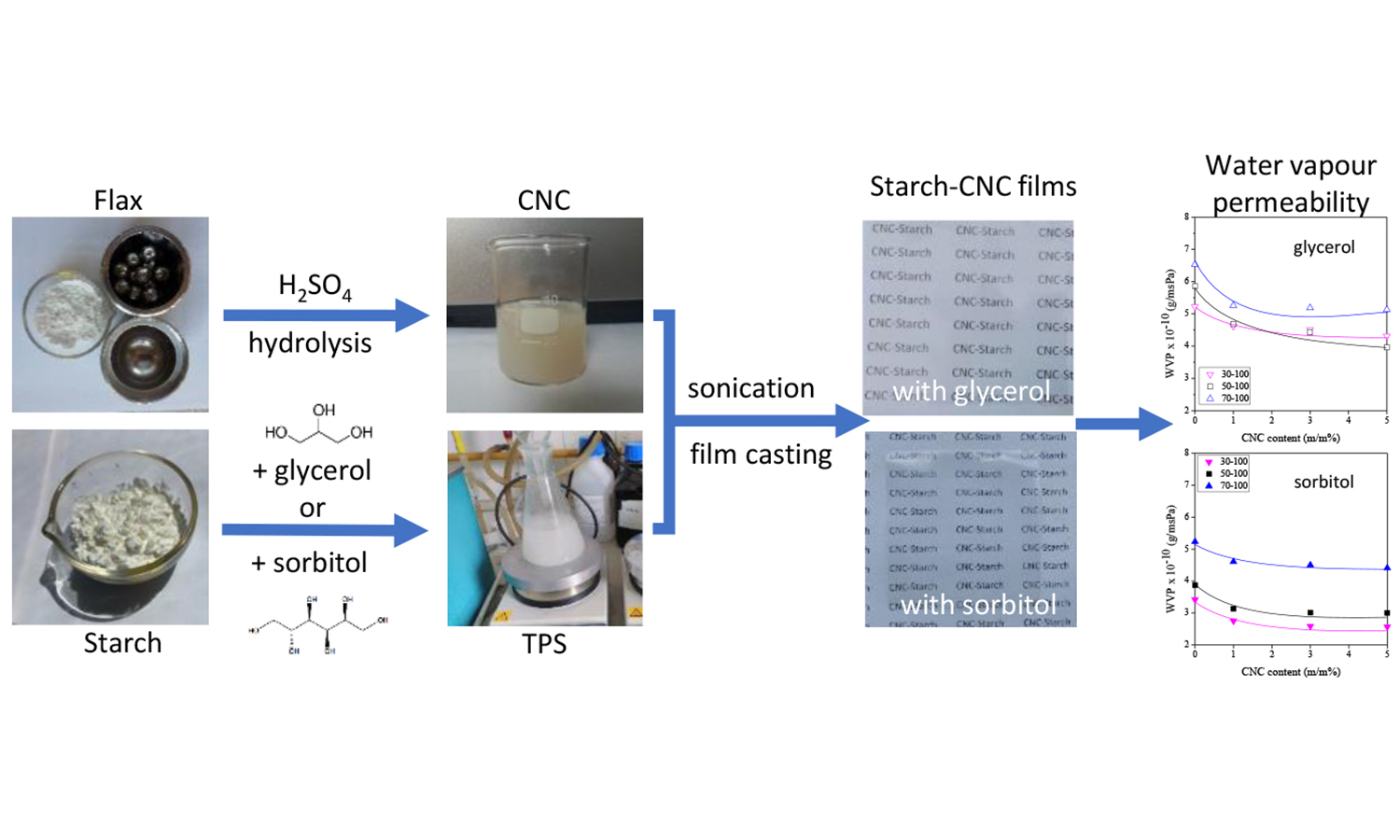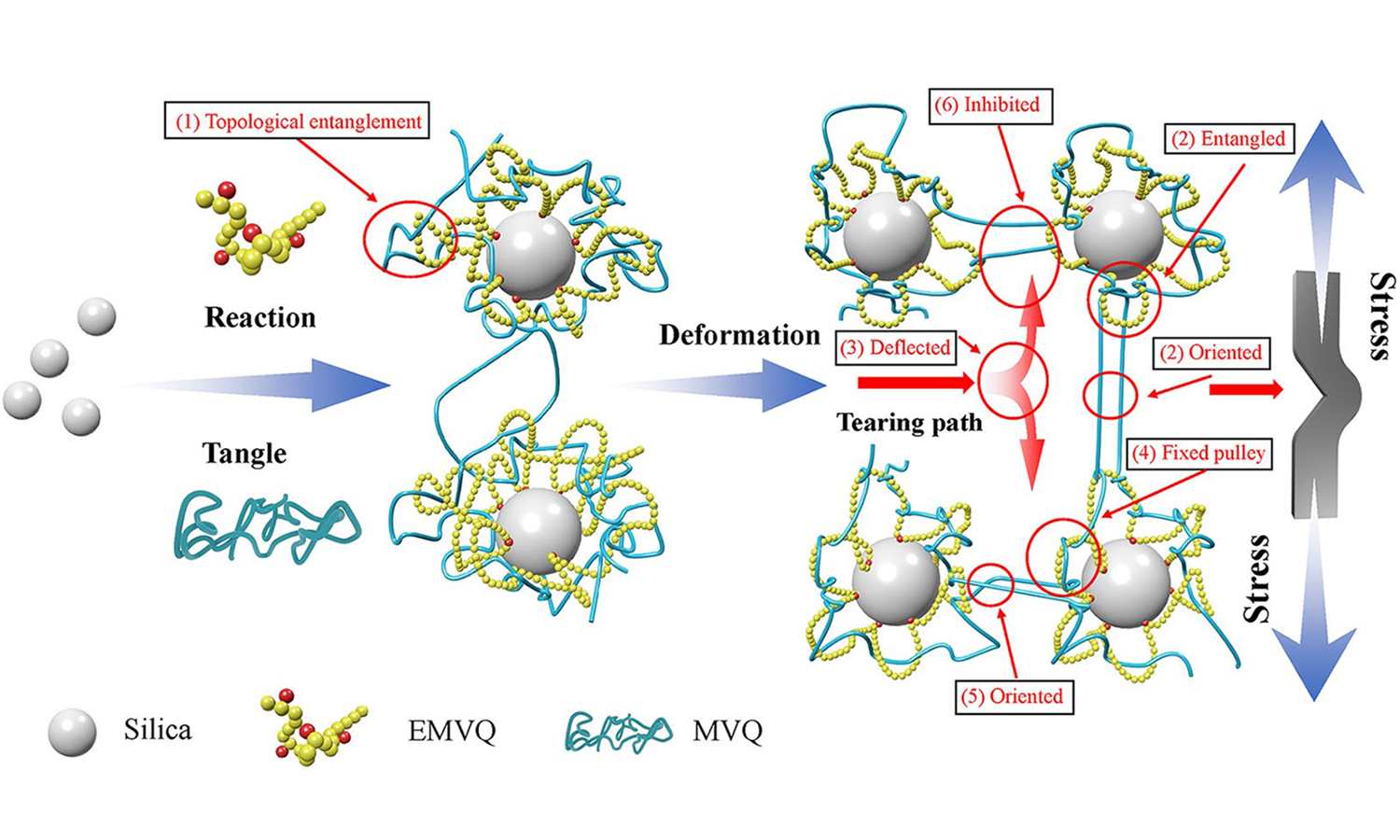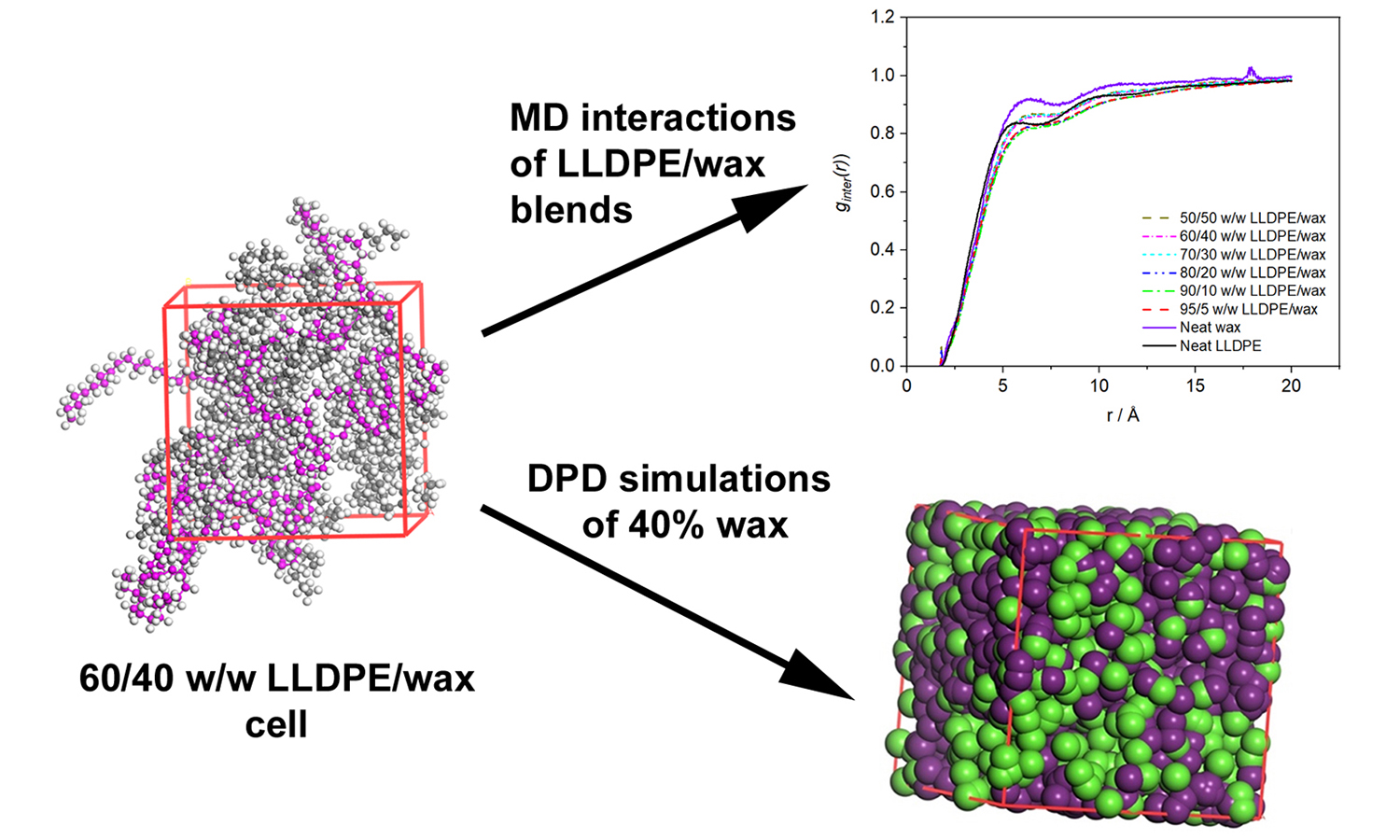Content
All issues / Volume 17 (2023) / Issue 5 (May)

This is an editorial article. It has no abstract.

Thermoplastic starch (TPS)/cellulose nanocrystal (CNC) films with glycerol or sorbitol plasticizers at 30 and 40% concentrations were prepared by casting over the whole composition range. The nanocrystalline cellulose was extracted from bleached flax by sulphuric acid hydrolysis. The haziness, tensile strength, thermal stability, and the effect of storage on crystal structure were investigated. Water vapor sorption of the neat TPS and flax-CNC films and water vapor permeability of the composites were measured at various humidity differences. The results showed that the high aggregation tendency of flax-CNCs significantly increases the opacity of films regardless of the type and amount of plasticizer. The reinforcing effect of nanocrystals can only be exploited at small concentrations (0–5%). However, 3–4% flax-CNCs result in a 15–25% reduction in water vapor permeability. Retrogradation of the TPS also reduced without changing the thermal stability. The properties of composites and their compositional dependence differ significantly from those of the composites prepared previously with cotton-CNC. Thus, knowledge of the properties of CNCs is essential for explaining the properties of polymer/CNC composites and the compositional dependence of properties.

Graphene oxide (GO) at different contents, ranging from 0 to 0.5 wt%, was exploited to develop the interfacial adhesion between matrix and fiber in flax/epoxy composites. A proposed mechanism, which was substantiated by Fourier transform infrared spectroscopy, demonstrated that GO, thanks to possessing oxygen-containing functional groups, acted as a coupling agent between epoxy matrix and flax fiber. As a result of the developed interfacial bonding between composite constituents, significant improvements in tensile strength (68%) and flexural strength (65%) of composites up to 0.3 wt% were recorded. According to X-ray diffraction (XRD) and transmission electron microscopy (TEM) observations, all nanocomposites formed an exfoliated structure. Microscopic observations depicted a substantial decline in the total crack lengths of composites and also the rate of cracks formed at the interface of fiber and matrix. It was also found that thanks to the developed interfacial adhesion between epoxy matrix and flax fiber, major defects responsible for composite premature failure did substantially reduce. In low-velocity impact test, resultant nanocomposites showed enhanced peak loads and damage tolerance owing to a strong interfacial adhesion developed by GO presence. Scanning electron microscopy (SEM) images of the impact-fractured surface of nanocomposites showed the risk mitigation of catastrophic damages, with the inclusion of GO, due to the efficient fiber adherence to the matrix.

This study aims to produce drug delivery systems using ultrasonic spray pyrolysis (USP) and electrospinningp methods. For this purpose, the study was carried out in two steps. In the first step, polyvinylpyrrolidone (PVP)/gelatin (GEL) based nanofibers were produced by the electrospinning method. The nanofibers were coated with azithromycin (AZI) in the second step using the USP method. Finally, characterization studies such as morphological, chemical, and thermal were carried out, and drug release behaviors were analyzed. The findings show that nanofibers are noticeably fine, smooth, and uniform. Although burst release was observed for the first time because the drug molecules were located on the nanofibrous surface, the release time was increased from 30 min to 48 h by obtaining sandwich structures. The results showed that the USP method could be used to produce new drug delivery systems with the electrospinning method.

In this work, cis-1,4-polybutadiene rubber/polystyrene-butadiene rubber (BR/SBR) blend was filled with inorganic lightweight filler hollow glass microspheres (HGMs) to develop a rubber-based lightweight composite. Cu-plating was carried out on the surface of HGMs by polydopamine (PDA) and Ag nanoparticles to improve the compatibility among HGMs and rubber matrix. Filter paper experiment, X-ray energy dispersive spectroscopy (EDS) and X-ray photoelectron spectrometer (XPS) were used to analyze the bonding mechanism between Cu-plated HGMs and rubber. The results confirmed that the redox reaction between the reactive sulfur in the rubber matrix and Cu on the surface of Cu-plated HGM can be successfully carried out at 170°C. And the compatibility between HGM and rubber matrix was obviously improved after Cu plating. The physical-mechanical properties and abrasion resistance of the composites were improved significantly. This research was of great significance to marine flexible floating body materials.

The poor tear resistance of silicone rubber dramatically limits its application range. In this study, a topological entanglement structure of molecular chains was constructed at the interface between the matrix and silica by introducing epoxidized silicone rubber into silicone rubber/silica composites. We found that this topologically entangled structure could improve the crack propagation resistance of the composites by inducing the orientation of molecular chains. The results showed that adding 5 phr of 15% epoxy silicone rubber raised the silicone rubber composite’s tear strength and elongation at break, they increased by 330% and 140, respectively. This work provides a new idea for preparing silicone rubber composites with high tear resistance to better expand the application field of silicone rubber.
A new testing strategy based on the wetting concept for characterizing rubber-filler interaction in rubber compounds and its application to the study of the influence of epoxy groups and non-rubber components on rubber-filler interaction in natural rubber
Hai Hong Le, Tung Xuan Hoang, Syed Bilal Haider, Subhradeep Mandal, Uta Reuter, Kedar Dhakal, Rameshwar Adhikari, Katrin Reincke, Subhan Saleah, Sven Wiessner
Vol. 17., No.5., Pages 527-545, 2023
DOI: 10.3144/expresspolymlett.2023.39
Vol. 17., No.5., Pages 527-545, 2023
DOI: 10.3144/expresspolymlett.2023.39

In the present work, a new testing strategy was proposed to characterize the effect of a functional group on the interaction between rubber and filler in a rubber compound. In principle, the filler is mixed into a blend of rubber A and rubber B produced by functionalizing the rubber A with a specific chemical group. The phase-selective wetting of the filler is directly related to the effect of the functional group. Based on the new test approach, the impact of the non-rubber components in natural rubber (NR) and its epoxidation on the rubber-filler interaction in carbon black (CB) filled NR compounds was investigated. Accordingly, CB was mixed in three blends consisting of NR/isoprene (IR), deproteinized natural rubber (DPNR)/IR, and NR/epoxidized natural rubber (ENR). The phase selective wetting of CB was quantitatively characterized based on the wetting concept. It was found that proteins and epoxy groups did not affect the affinity between NR and CB, while the linked phospholipids interacted with the CB surface through cation-π bonding. By fitting the experimentally determined selective wetting of CB into the Z-model, the corrected surface tension of NR describing the effect of phospholipids was determined. The proposed test strategy was applied to other NR blends filled with silica and the hybrid CB/silica filler as reference fillers to demonstrate its transferability and verification.

Atomistic molecular dynamics and dissipative particle dynamics simulations have been applied to study the miscibility of long- and short-chain linear low-density polyethylene (LLDPE)/wax blends. Molecular dynamics (MD) studies focused on selected mass ratios of LLDPE/wax blends to compare the simulations to published experimental results. The solubility parameters of the pure components and blends were computed to determine the Flory-Huggins interaction parameter (χAB) of the binary systems. Because the critical Flory-Huggins interaction parameter (χAB)critical was larger than χAB for all the mass ratios investigated, wax and LLDPE were expected to be completely miscible at all mass ratios. The results from the Flory-Huggins interaction parameter agree with the modelled glass transition temperature (Tg) values obtained for the blends. However, these results could not be used to explain the blends’ miscibility characteristics because the highly crystalline wax does not show a glass transition. The partial miscibility of the blends was, however, observable from the dissipative particle dynamics (DPD) simulation results. These results showed clumps of wax chains in the blend matrices. The simulation results further showed that the wax chains interacted more strongly with the short than with the long LLDPE chains, which was the final observation that supported the partial miscibility of the wax and LLDPE in the LLDPE/wax blends.


